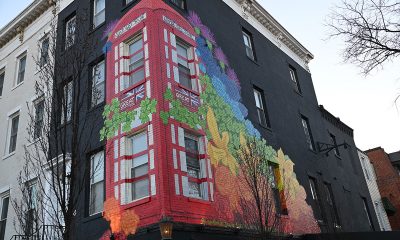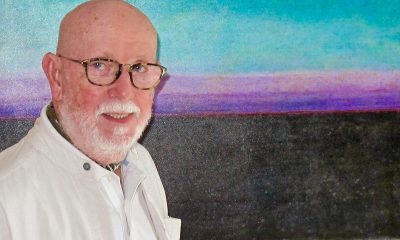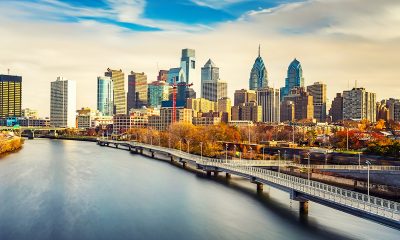a&e features
Longtime Creating Change conference organizer looks back
Boston’s Sue Hyde says diversity was always key component of annual event
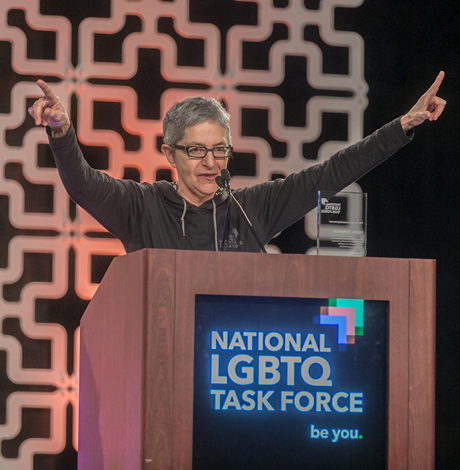
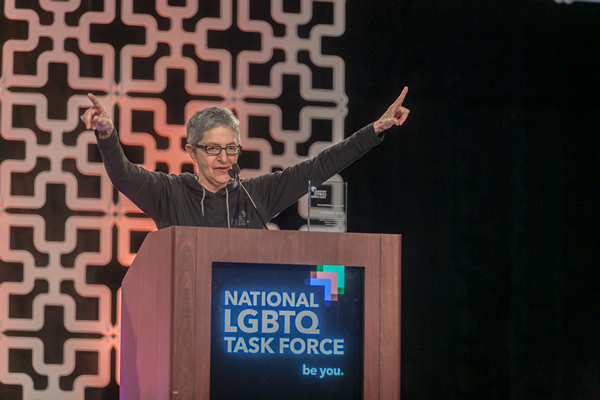
Sue Hyde speaks at the Creating Change Conference. The long-time Boston resident is stepping down after decades overseeing the annual event. (Photo courtesy the Task Force)
Even in big U.S. cities with diverse residents, activist groups sometimes default into overabundances of white, gay, cis men. Organizers of Creating Change, the annual conference of the National LGBTQ Task Force, knew from the start they wanted diversity, but it didn’t just happen. Not by a long shot.
One of the founding principles behind the conference was to “build a stronger, more confident, more skilled, more connected and more representative LGBTQ political movement,” says longtime organizer Sue Hyde.
“People say Creating Change is one of the most diverse LGBTQ political events they attend and we worked hard to make that happen,” Hyde says. “We wanted a conference that would bring people together across age, across race, across income and across geography in the sense that we were very interested in attracting people from not just urban or suburban but also small towns and rural areas.”
She doesn’t know the median age of attendees but at the 2017 conference in Philadelphia, 47 percent of attendees were 30 or younger. About 49 percent identified as something other than European/Caucasian and 30 percent reported incomes of $35,000 or less. Another 22 percent identified as either gender non-conforming or transgender. Seventeen percent were from small towns and rural areas.
“From the get go, we were very conscious of wanting the attendee base of Creating Change to be reflective of who we believed the LGBT communities were comprised,” Hyde says.
The 30th annual Creating Change Conference is Jan. 24-28 at the Marriott Wardman Park in Washington. About 3,500 are expected; 1,500 have signed up for a Capitol Hill lobby day that’s part of the event. The theme is “Learn. Connect. Resist.” The Task Force bills its event as the “foremost political, leadership and skills-building conference for the LGBTQ social justice movement.” The primary goal each year is for the conference to “build the LGBTQ movement’s political power from the ground up to secure our overarching goal of full freedom, justice and equality for (LGBTQ) people in the United States.”
Registration is still open and several tiers are available including daily rates ($180), conference passes for students/limited income ($210), regular ($475), senior and youth rates, sponsoring rates and more. Full details at creatingchange.org.
Moving on
It will also be Hyde’s last. One of the conference founders, Hyde has been its director every year except 1990-1993 when she left the Task Force for a few years to work on some other community organizing projects in the Boston area where she lives to this day despite the Task Force’s Washington headquarters. Hyde, 65, will continue to work on queer and social justice issues in a new role with the Wild Geese Foundation, an organization that works to make grants more accessible. She will continue to live in Massachusetts with her partner/wife of 35 years, with whom she has two adult children.
Her resignation inspired a spate of glowing comments. Task Force director Rea Carey said in a statement that Hyde’s impact on the movement of three decades is “immeasurable and unmatched.” Former director Urvashi Vaid called her “one of the most effective organizers with whom I have ever worked.”
Beth Zremsky, a longtime activist and with “28 or 29” Creating Change conferences notched (she doesn’t recall for sure but knows she missed a couple years), probably the record holder, says she feels Hyde’s supreme strength has been her ability to give the conference what it needed along the way to grow and evolve.
“She’s been able to adapt Creating Change both to respond to the issues of the day but also to really be inclusive of the people who are there,” Zremsky says by phone from her home in Minneapolis. “It’s never perfect, but she’s figured out a way to embody the values we say we care about. We say it’s about everybody bringing their full self but to be able to offer a space for 4,000 people to be their full selves, that takes a ton of intentionality. Everything from gender-neutral bathrooms, interpreters, food for all the low-income people so they can come and not worry about getting fed, I could go on and on. I often use Creating Change as an example of what it would really look like to create an intentional community just for five days that’s completely seen and completely held so they can do the work we need to do as a movement.”
Growing pains
And, as one would imagine, 30 years of conferences don’t happen without some snags along the way. Some are logistical. Hyde remembers one year the conference was at a fully unionized hotel but organizers failed to realize members of the audio-visual team also needed a union salary, significantly higher than what had been budgeted. Planning the conference is a year-round effort for Hyde and her team of four who work only on the conference (other Task Force staff members work on the conference and other duties).
Hyde mostly shrugs off any suggestions of rancor along the way and says, having worked under 10 Task Force directors over the years, each of whom “had their own idea about what they thought the programming should look like,” a few hiccups were to be expected.
“Yeah, I’ve taken a lump or two but it comes with the territory,” she says. “But along with the lumps have been a great deal of very satisfying and really gratifying experiences of bringing together now thousands of people who are committed equally to securing freedom and justice and equality and liberation so the lump is not really what I want to remember or think about. I tend to think much more about the incredibly beautiful metabolism of Creating Change and our movement coming together every year. It’s a political organization but also a family reunion.”
Zremsky sees it slightly differently.
“One of the things Sue is a master at, as is Urvashi, is the idea that for something to be a movement, it needs to move,” Zremsky says. “They’ve kept Creating Change moving with the movement and Sue is one of the most graceful people I know when it comes to dealing with conflict and allowing conflict to be a growth opportunity. She leans into it as a way to sort of say, ‘Hey, this is our growth point.’”
The conference started as an outgrowth of the second National March on Washington for Lesbian and Gay Rights in 1987. Then Task Force director Jeff Levi “looked at us like we’d lost our minds,” Hyde recalls when she and others pitched the idea.
“He thought we were crazy but he agreed to go forward, which was a good thing, and pretty much left it in the hands of me and Urvashi to deal with the logistics,” Hyde says.
Making it work
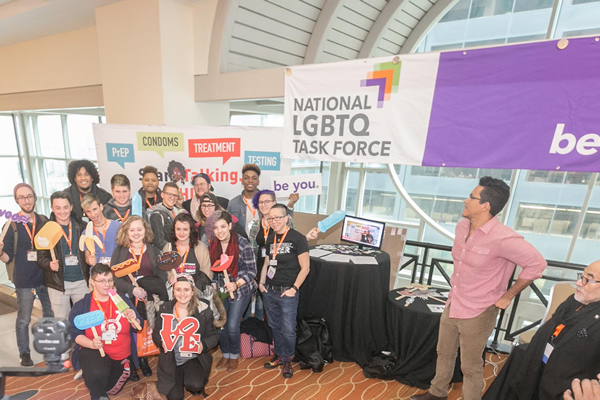
A group of attendees at the 2017 Creating Change Conference. (Photo courtesy the Task Force)
The conference is held in a different city each year. This is the second time it’s been in Washington. The first was in 1988 for its inaugural event though it was held in Bethesda, Md., in 1989; Arlington, Va., in 1991 and Alexandria, Va., in 1996. Several cities have hosted twice including Detroit (’95 and ’08), Minnesota (’91 and ’11), Denver (’09 and ’15) and Dallas (’94 and ’10) among others. Hyde says she can’t name a favorite host city but has enjoyed seeing integration among activist circles increase upon returning to areas years later. It was especially pronounced in Detroit, she says.
About 300 folks attended the first conference in 1988. Peak attendance was in 2016 in Chicago with about 4,600. It’s been between 3,000-4,000 for the past few years.
Hyde guesses the first conference budget was around $65,000. She can’t say what it is for 2018.
And although the Task Force does not view the conference as a moneymaker, its goal, Hyde says, is “to do better than break even. Exact figures, she says, are impossible to fully extricate from the overall Task Force operations because of the carryover of staff, supplies and overhead that aren’t designated fully to either the conference or other Task Force areas. There have been times the conference has not broken even, but it’s been rare.
Calamities have been few. A 1996 tornado made it impossible for the keynote speaker to fly into Alexandria from California. A substitute who could arrive by train from New Jersey was quickly found. Hyde says that was the biggest logistical snafu she recalls.
One of the most tedious aspects to pulling it off each year is going through the more than 600 proposals submitted for session topics each year only about half of which can be approved. Hyde says it’s important that each is given careful consideration.
On the conference floor itself, Hyde says she has her game face on.
“I’m the trouble-shooter in chief, so when things are going a little bit awry, I am often involved in pulling people together so it’s not like going to your own dinner party. You have 3,000 people in a building. I believe in customer service and I try to treat every conversation as though it’s the first conversation of the day even if it’s the 100th. I try to give people my full attention, my best problem-solving skills and my best conflict mediation skills.”
a&e features
Queer highlights of the 2026 Critics Choice Awards: Aunt Gladys, that ‘Heated Rivalry’ shoutout and more
Amy Madigan’s win in the supporting actress category puts her in serious contention to win the Oscar for ‘Weapons’

From Chelsea Handler shouting out Heated Rivalry in her opening monologue to Amy Madigan proving that horror performances can (and should) be taken seriously, the Critics Choice Awards provided plenty of iconic moments for queer movie fans to celebrate on the long road to Oscar night.
Handler kicked off the ceremony by recapping the biggest moments in pop culture last year, from Wicked: For Good to Sinners. She also made room to joke about the surprise hit TV sensation on everyone’s minds: “Shoutout to Heated Rivalry. Everyone loves it! Gay men love it, women love it, straight men who say they aren’t gay but work out at Equinox love it!”
The back-to-back wins for Jacob Elordi in Frankenstein and Amy Madigan in Weapons are notable, given the horror bias that awards voters typically have. Aunt Gladys instantly became a pop culture phenomenon within the LGBTQ+ community when Zach Cregger’s hit horror comedy released in August, but the thought that Madigan could be a serious awards contender for such a fun, out-there performance seemed improbable to most months ago. Now, considering the sheer amount of critics’ attention she’s received over the past month, there’s no denying she’s in the running for the Oscar.
“I really wasn’t expecting all of this because I thought people would like the movie, and I thought people would dig Gladys, but you love Gladys! I mean, it’s crazy,” Madigan said during her acceptance speech. “I get [sent] makeup tutorials and paintings. I even got one weird thing about how she’s a sex icon also, which I didn’t go too deep into that one.”
Over on the TV side, Rhea Seehorn won in the incredibly competitive best actress in a drama series category for her acclaimed performance as Carol in Pluribus, beating out the likes of Emmy winner Britt Lower for Severance, Carrie Coon for The White Lotus, and Bella Ramsey for The Last of Us. Pluribus, which was created by Breaking Bad’s showrunner Vince Gilligan, has been celebrated by audiences for its rich exploration of queer trauma and conversion therapy.
Jean Smart was Hack’s only win of the night, as Hannah Einbinder couldn’t repeat her Emmy victory in the supporting actress in a comedy series category against Janelle James, who nabbed a trophy for Abbott Elementary. Hacks lost the best comedy series award to The Studio, as it did at the Emmys in September. And in the limited series category, Erin Doherty repeated her Emmy success in supporting actress, joining in yet another Adolescence awards sweep.
As Oscar fans speculate on what these Critics Choice wins mean for future ceremonies, we have next week’s Golden Globes ceremony to look forward to on Jan. 11.
a&e features
Looking back at the 10 biggest A&E stories of 2025
‘Wicked,’ Lady Gaga’s new era, ‘Sexy’ Bailey and more

Although 2025 was a year marked by countless attacks on trans rights and political setbacks, the year also saw brilliant queer artists continuing to create art. From Cannes and Sundance Award winners now vying for Oscar consideration to pop icons entering new stages of their careers, queer people persevered to tell their stories through different media.
With the state of the world so uncertain, perhaps there’s no more vital time to celebrate our wins, as seen through some of this year’s top pop culture moments. While there’s no collection of 10 stories that fully encompass “the most important” news, here are some events that got the gays going:
10. ‘Mysterious Gaze of the Flamingo’ wins big at Cannes

The Cannes Film Festival has become a crucial start for films hoping to make their way to the Oscars, and first-time director Diego Céspedes won the top Un Certain Regard prize for his intimate western “The Mysterious Gaze of the Flamingo.” The film is set in the ‘80s and is intended as an allegory for the AIDS epidemic. Seeing a film that unpacks vital queer history win one of the most coveted awards at Cannes has been a huge point of pride in the independent filmmaking community.
Since the film bowed at Cannes, it has been selected as Chile’s Oscar entry in the Best International Feature race. Speaking with The Blade during the film’s AFI Fest run in October, Céspedes said: At first, I was kind of scared to have this campaign position in the times that we’re living [in] here. But at the same time, I think the Oscars mean a huge platform — a huge platform for art and politics.”
9. ‘The Last of Us’ returns for an even gayer season 2
While the first season of The Last of Us gave us one of TV’s most heartbreaking queer love stories in the episode “Long, Long Time,” Season 2 doubled down on its commitment to queer storytelling with the blossoming relationship between Ellie (Bella Ramsey) and Dina (Isabela Merced). The show expanded on the pair’s relationship in the original video game, making it perhaps the central dynamic to the entire season. That unfortunately came with more homophobic backlash on the internet, but those who checked out all the episodes saw a tender relationship form amid the show’s post-apocalyptic, often violent backdrop. For their performance, Ramsey was once again nominated for an Emmy, but Merced deserved just as much awards attention.
8. ‘Emilia Pérez’ sparks controversy
Jacques Audiard’s genre-bending trans musical “Emilia Pérez” proved to be an awards season juggernaut this time last year, winning the Golden Globe for Best Musical/Comedy. But when the lead star Karla Sofia Gascón’s racist, sexist, and homophobic old tweets resurfaced, the film’s Oscar campaign became a tough sell, especially after Netflix had tried so hard to sell Emilia Pérez as the “progressive” film to vote for. Mind you, the film had already received significant backlash from LGBTQ+ audiences and the Mexican community for its stereotypical and reductive portrayals, but the Gascón controversy made what was originally just social media backlash impossible to ignore. The only person who seemed to come out of the whole debacle unscathed was Zoe Saldaña, who won the Oscar for Best Supporting Actress over Ariana Grande.
7. ‘Sorry, Baby’ establishes Eva Victor as major talent
Back in January at the Sundance Film Festival, Eva Victor (known by many for her brand of sketch comedy) premiered their directorial debut “Sorry, Baby” to rave reviews, even winning the Waldo Salt Screening Award. Victor shadowed Jane Schoenbrun on the set of “I Saw the TV Glow,” and seeing Victor come into their own and establish such a strong voice immediately made them one of independent cinema’s most exciting new voices. A memorable scene in the film sees the main character, Agnes (played by Victor), struggling to check a box for male or female, just one example of how naturally queerness is woven into the fabric of the story.
Most recently, Victor was nominated for a Golden Globe for her performance in the film, and she’s represented in a category alongside Jennifer Lawrence (“Die My Love”), Jessie Buckley (“Hamnet”), Julia Roberts (“After the Hunt”), Renate Reinsve (“Sentimental Value”) and Tessa Thompson (“Hedda”). The film also received four Independent Spirit Award nominations overall.
6. Paul Reubens comes out in posthumous doc

While Paul Reubens never publicly came out as gay before passing away in 2023, the two-part documentary “Pee-wee as Himself” premiered back in May on HBO Max, giving the legendary comedian a chance to posthumously open up to the world. Directed by Matt Wolf, the documentary explores how Reubens found his alter ego Pee-Wee Herman and why he kept his private life private.
The documentary won an Emmy in the Outstanding Documentary or Nonfiction Special category and remains one of the most critically acclaimed titles of the year with a 100% Rotten Tomatoes score. Also worth noting, the National Geographic documentary Sally told the posthumous coming out story of Sally Ride through the help of her long-time partner, Tam O’Shaughnessy.
5. Lady Gaga releases ‘Mayhem’
Lady Gaga entered a new phase of her musical career with the release of Mayhem, her seventh album to date. From the frenzy-inducing pop hit Abracadabra to the memorable Bruno Mars duet featured on “Die With a Smile,” seeing Gaga return to her roots and make an album for the most die-hard of fans was especially rewarding after the underwhelming film releases of “House of Gucci” and “Joker: Folie à Deux.” Gaga has been touring with The Mayhem Ball since July, her first arena tour since 2018. She even extended her tour into 2026 with more North American dates, so the party isn’t stopping anytime soon. And Gaga is even set to make an appearance next May in “The Devil Wears Prada 2.”
4. Cynthia Erivo, Ariana Grande perform at the Oscars

While “Wicked: For Good” didn’t quite reach the heights of the first film, we will forever have Cynthia Erivo and Ariana Grande’s breathtaking live performance that opened the 97th Academy Awards. The pair sang a rendition of “Over the Rainbow,” “Home,” and “Defying Gravity,” paying proper homage to the original 1939 “Wizard of Oz.” Even non-Wicked fans can’t deny how magical and brilliantly staged this performance was. With both Erivo and Grande up for acting Oscars last year, they’re hoping to repeat success and make history with consecutive nominations. Either way, let’s hope there’s another live performance in the making, especially with two new original songs (The Girl in the Bubble and No Place Like Home) in the mix.
3. Indya Moore speaks out against Ryan Murphy
Indya Moore has consistently used social media as a platform for activism, and in September, posted a 30-minute Instagram live speaking out against “Pose” co-creator Ryan Murphy. Moore claimed that Murphy wasn’t being a true activist for trans people. “Ryan Murphy, we need you to do more. You need to address the racism, the violence, and the targeting of people on your productions, Ryan Murphy. You do need to make sure trans people are paid equally. Yes, Janet did the right thing,” Moore said. Murphy was also back in the headlines this year for the critically panned “All’s Fair” and the controversial “Monster: The Ed Gein Story” starring Laurie Metcalf and Charlie Hunnam.
2. Cole Escola wins Tony for Best Leading Actor
Few pop culture moments this year brought us together more than Cole Escola winning a Tony award for “Oh, Mary!” the Broadway show they created, wrote and starred in (we love a triple threat!) Escola made history by becoming the first nonbinary person to win a Tony in the leading actor category, and seeing them excitedly rush to the stage wearing a Bernadette Peters-inspired gown instantly became a viral social media moment.
The cherry on top of Escola’s major moment is the recent news that they are writing a Miss Piggy movie with Jennifer Lawrence and Emma Stone producing — news that also broke the internet for the better. We cannot wait!
1. Jonathan Bailey makes gay history as ‘Sexiest Man Alive’

The same year as his on-screen roles in blockbusters “Jurassic World Rebirth” and “Wicked: For Good,” Jonathan Bailey made history as the first openly gay man to be named People magazine’s “Sexiest Man Alive.” The fact that it took 40 years for an openly gay man to earn the title is a signifier of how far we still have to go with queer representation, and seeing Bailey celebrated is just one small step in the right direction.
“There’s so many people that want to do brilliant stuff who feel like they can’t,” he told PEOPLE, “and I know the LGBT sector is under immense threat at the moment. So it’s been amazing to meet people who have the expertise and see potential that I could have only dreamed of.” In 2024, Bailey founded the charity titled The Shameless Fund, which raises money for LGBTQ+ organizations.
a&e features
Your guide to D.C.’s queer New Year’s Eve parties
Ring in 2026 with drag, leather, Champagne, and more

With Christmas in the rear view mirror, we can turn our attention to ringing in a much-anticipated New Year with a slew of local LGBTQ parties. Here’s what’s on tap.
Pitchers
This spacious Adams Morgan bar is hosting the “Pitchers’ Perfect New Year’s Eve.” There will be a midnight Champagne toast, the ball drop on the big screens, and no cover, all night long. The bar doesn’t close until 4 a.m., and the kitchen will be open late (though not until close). All five floors will be open for the party, and party favors are promised.
Trade
D.C.’s hottest bar/club combo is leaning into the Shark motif with its NYE party, “Feeding Frenzy.” The party is a “glitterati-infused Naughty-cal New Year’s Even in the Shark Tank, where the boats are churning and the sharks are circling.” Trade also boasts no cover charge, with doors opening at 5 p.m. and the aforementioned Shark Tank opening at 9 p.m.. Four DJs will be spread across the two spaces; midnight hostess is played by Vagenesis and the two sea sirens sensuously calling are Anathema and Justin Williams.
Number Nine
While Trade will have two DJs as part of one party, Number Nine will host two separate parties, one on each floor. The first floor is classic Number Nine, a more casual-style event with the countdown on TVs and a Champagne midnight toast. There will be no cover and doors open at 5 p.m. Upstairs will be hosted by Capital Sapphics for its second annual NYE gathering. Tickets (about $50) include a midnight Champagne toast, curated drink menu, sapphic DJ set by Rijak, and tarot readings by Yooji.
Crush
Crush will kick off NYE with a free drag bingo at 8 p.m. for the early birds. Post-bingo, there will be a cover for the rest of the evening, featuring two DJs. The cover ($20 limited pre-sale that includes line skip until 11 p.m.; $25 at the door after 9 p.m.) includes one free N/A or Crush, a Champagne toast, and party favors (“the legal kind”). More details on Eventbrite.
Bunker
This subterranean lair is hosting a NYE party entitled “Frosted & Fur: Aspen After Dark New Year’s Eve Celebration.” Arriety from Rupaul Season 15 is set to host, with International DJ Alex Lo. Doors open at 9 p.m. and close at 3 p.m.; there is a midnight Champagne toast. Cover is $25, plus an optional $99 all-you-can-drink package.
District Eagle
This leather-focused bar is hosting “Bulge” for its NYE party. Each District Eagle floor will have its own music and vibe. Doors run from 7 p.m.-3 a.m. and cover is $15. There will be a Champagne toast at midnight, as well as drink specials during the event.
Kiki, Shakiki
Kiki and its new sister bar program Shakiki (in the old Shakers space) will have the same type of party on New Year’s Eve. Both bars open their doors at 5 p.m. and stay open until closing time. Both will offer a Champagne toast at midnight. At Kiki, DJ Vodkatrina will play; at Shakiki, it’ll be DJ Alex Love. Kiki keeps the party going on New Year’s Day, opening at 2 p.m., to celebrate Kiki’s fourth anniversary. There will be a drag show at 6 p.m. and an early 2000s dance party 4-8 p.m.
Spark
This bar and its new menu of alcoholic and twin N/A drinks will host a NYE party with music by DJ Emerald Fox. Given this menu, there will be a complimentary toast at midnight, guests can choose either sparkling wine with or without alcohol. No cover, but Spark is also offering optional wristbands at the door for $35 open bar 11 p.m.-1 a.m. (mid-shelf liquor & all NA drinks).

